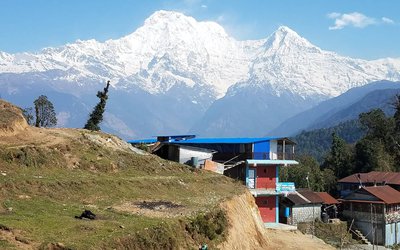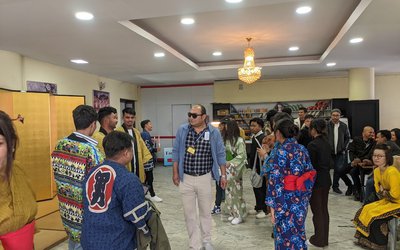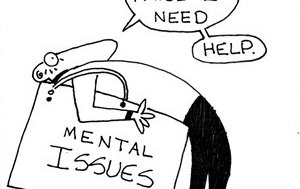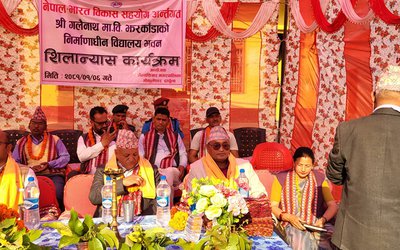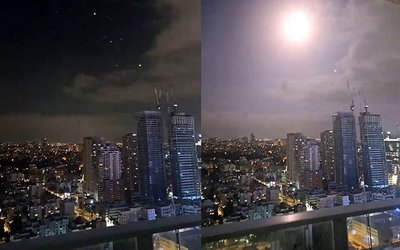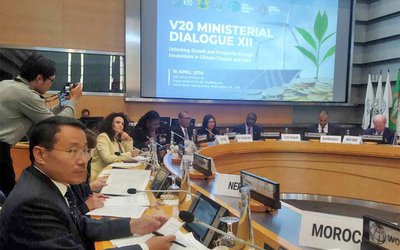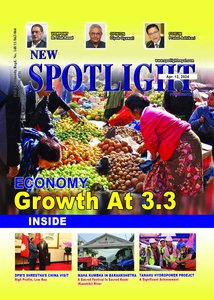Now that the Gol Mech (round table) conference has turned into a Golmaal (chaotic) Match of political mudslinging, the confused voters of Nepal are forced to face uncomfortable truths. The stench from raw political wounds that Loktantrick snake oil salesmen have tried their best to hide under fancy dressings is too overpowering to ignore. Their latest sales pitch is “elections however for whatever” as the new path to political nirvana. Without it the country faces doom, they bleat hysterically. They have similarly cried “Wolf!” every time in the past – from the need to illegitimately self-extend the CAfour times beyond the voters’ mandate, indeed about the CA itself as the solution to all ills in Nepal as well as the 12-point Delhi Deal that led the country down this path of reckless adventurism. Their shrill sales pitch now sounds fake and hollow even to rustics in the hinterland who aren’t buying it.
The big elephant in the room is why the CA collapsed and what corrective measures need to be taken so that the proposed new one won’t collapse again. The failed, vision-less leaders are the same; their parties are still feudocratic and unable to present any new faces or ideas; and most important, they have failed to conduct any soul-searching to acknowledge their accountability. The CA failed because from its very birth it carried the “mark of Cain” as the illegitimate carrier of pre-ordained geo-political sins, and its four-year actions were procedurally so flawed they compounded those sins into fatal cancer. A handful of oligarchs took all the decisions behind closed doors and used the CA as a spineless rubber-stamp. The second-rung political leadership within the main parties – who were willing rubber-stamps – are today angry that they are being blamed for the late CA’s failure. They might well be: after all they too have shown no leadership courage to challenge their failed leaders or to convincingly propose corrective measures. Just asking for votes will not move jaded Nepali voters away from deepening bouts of nihilism.
What might such new ideas be that could excite voters and give them hope? The insipid British prime minister Harold Wilson once said that a week is a long time in politics, implying that, unlike long-term statesmanship, garden-variety power brokers are preoccupied with the very short-term. Nepal’s current crop political leaders are particularly myopic and assume history too is as blinkered and does not hold them accountable for the two festering wounds of their making: their own dismal misjudgments since 1990 for which they avoid accountability, and their incompetence to address the larger complex issues of governance without which no new stable architecture can be built.Holding elections in the absence of a well-founded political architecture will result in a rickety House that will not sustain the strains of living with everyday politics and will inevitably collapse like the last CA. Experience since 1990, nay ever since 1957, indicates that, if a Westminster parliamentary model is to succeed in Nepal’s alien soil far from the land of its birth, the following structural reforms have to be in place before a new House is built.
In a multi-party election, the first-past-the-post system has ensured only parliaments, and hence governments that represented a minority of voters. The victorious MPs would have won with less than a quarter of the votes, and over three-fourths of the voters would not have voted for them. This birthmark of inherent illegitimacy has to be corrected by requiring the winner to have received at least fifty percent of the votes and to have run-off elections among the top two contenders to assure this.
In order to ensure voter sovereignty and to force parties to put up honest and credible candidates, there must be the “California option” on the ballot paper, an option that allows the voter to say “none of the above”. If that option receives the highest or second highest number of votes, a re-election must be held with a fresh set of candidates. The problem of a parliament representing only a minority of the voters was to some extent solved in the late CA by assuring a second ballot of proportional representation. It made the CA the “most representative” in Nepal even if it turned out to be the most ineffective.
However, a few flaws that emerged in this new experiment need to be remedied. First, do not mix elected representatives with selected ones from the proportional system: keep the nominated ones in an “Upper House”. Second, to prevent party oligarchs from nominating incompetent or even corrupt henchmen, require that all parties competing in elections submit and publicize their list of potential nominees in order of priority. That (and the right of voters to recall the representatives if they failed to live up to voter expectations) would ensure the eventual legitimacy of, and respect for, eventual nominees in the proportional system through voter endorsement. It would also force parties to nominate capable and credible candidates, not the incompetent rubber-stamp lot we saw the last time.
There have been a lot of heartburns over a chief justice violating the hallowed principle of separation of powers and also becoming a chief executive. An even bigger flaw not discussed openly by our public intellectuals has been the Westminster model’s executive born not independently but from the legislature and sustained by its umbilical cord. This is the reason why Nepal’s past legislatures failed to fulfill their watchdog functions. When the Kangress sank into the corruption quagmire of Lauda and Dhamija scandals, the UML protested only half-heartedly in shadow-boxing style. Tha is because it hoped to do the same and rake in millions if it came to power, and indeed did so through the Chase Air scandal!
If one wished to ensure the structural separation of legislative and executive functions, one might use the proportional “Upper House” for that purpose. While the prime minister, directly elected to the “Lower House” from some constituency, would be the person who commanded a majority in the Lower House, no other legislator representing a constituency should be allowed to be a cabinet minister. They should only be picked from the proportional “Upper House” pre-approved by the Nepali voters. The added benefit of such an arrangement would be the need for parties to look for candidates with capability and expertise. Also, this divorcing of legislative duty from executive ones would keep them sequestered away from the temptation for executive corruption that Nepal’s parties and politicians engage in with impunity. It would then force elected representatives to be better public watchdogs and better legislators, thus minimizing executive misuse of power.
But none of the big parties or their leaders have even given a second’s thought to these challenging issues of political architecture, even less suggesting solutions for a New Nepal, because they have proved themselves incapable of statesmanship. Beyond reaching a position of power for personal and henchmen aggrandizement, they have no agenda, hence this bleating for meaningless elections even as the country cries for long-term visionaries. The political middle has collapsed morally; and similar to the collapse of a suspension bridge, only the poles at both ends remain standing, and only by tying cables to those two ends can a new middle be hoisted in place. A Gol Mech with these two polar ends – yes, Baidya’s Dash Maoists and Kamal Thapa’s RPP-N as the two alternative pillars that are left standing in this political and moral void – would have allowed some soul-searching into the sins mentioned above.
Even while disagreeing with these polar political positions, one has to admit they represent issues swept under the carpet all these years that, with the collapse of the CA, are coming back to haunt Nepali politics. Baidya, who resigned from the CA long before its illegitimate extension or collapse, represents a search for something other than the failed Westminster model. It is a matter of justified debate that Stalinist Leninism is not the solution, but his disgruntled Dash cadres do represent the remnants of political honesty behind a betrayed revolutionand the failed attempt to radically change Nepali society. Similarly, RPP-N represents evolutionary changes without discarding Nepaliness and its traditions, a constant reminder to voters of how the last CA was born and lived a fraudulent life. Both are a search for alternative models of governance that is not foreign-imposed as with the failed four-party middle. A Gol Mech with both these pillars and everything in between, howsoever clumsy, still represents hope amidst the gloom and might salvage a failing Nepali politics.

Dipak Gyawali
Gyawali is Pragya (Academician) of the Nepal Academy of Science and Technology (NAST) and former minister of water resources.
- Maldevelopment And Technology: Ethos Harbingering Coming Apocalypse
- Apr 03, 2024
- World Social Forum: Rethinking and Redefining Development Itself
- Feb 21, 2024
- Remembering An Inspiring Karma Yogi
- Jan 09, 2024
- New World Disorder And The Case For Ideology
- Dec 13, 2023
- Loktantra’s Moral Turpitude
- Nov 06, 2023


